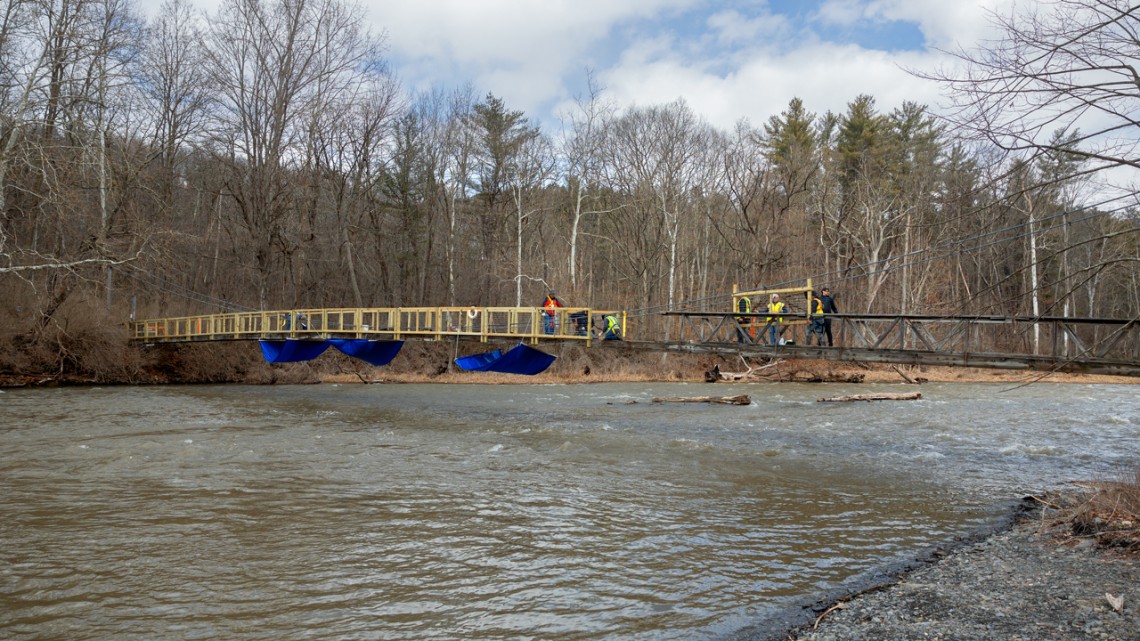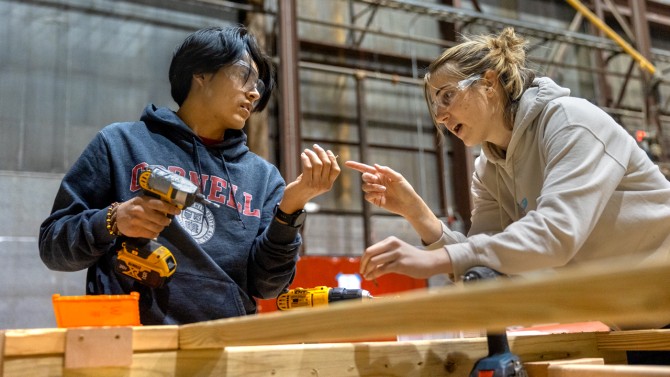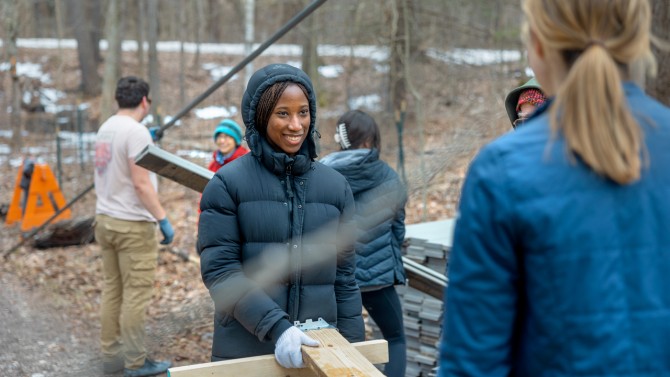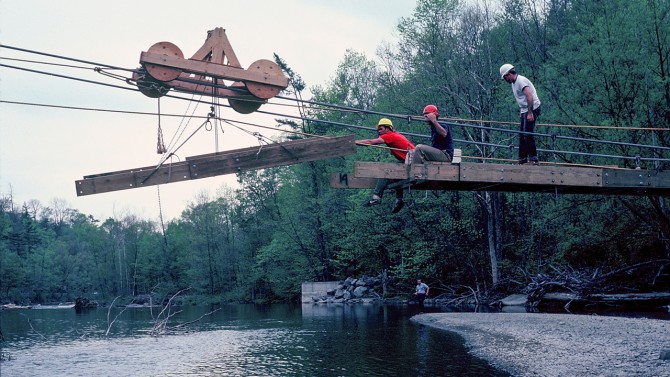
The 1983 student chapter of the American Society of Civil Engineers (ASCE) designed and built Flat Rock Bridge. Forty years later, the current student chapter of ASCE is renovating the bridge.
Repairs to Flat Rock Bridge span two generations
By Caitlin Hayes, Cornell Chronicle
In 1983, after a storm washed out an unstable pedestrian bridge over Ithaca’s Fall Creek, the Cornell student chapter of the American Society of Civil Engineers (ASCE) rebuilt it. Forty years later, in 2023, the current student chapter of ASCE is renovating the bridge for the next 40 years or more.
For these students and alumni, the bridge represents a meeting place, a legacy, a manifestation of what they’ve learned at Cornell, including the importance of serving the community.
“I think any civil engineer will tell you they like having a tangible outcome, they like getting to build something that everyone uses and everyone needs,” said Angela Melugin ‘23, a civil and environmental engineering (CEE) major in Cornell Engineering and president of the current ASCE student chapter. “For me, getting to be hands-on and to actually build something that will impact the community – it’s a huge learning opportunity for us.”
“The bridge gave us the confidence that you can make something big happen,” said Mark Ehlen ’83, Ph.D. ‘96, who helped design and build the bridge in 1983 and is now a consultant for the National Nuclear Security Administration. “It showed us that we had the abilities and the smarts to do it. It was and, to this day, is still foundational for me, to work with a group of people who are so passionate and respectful of one another’s contributions. It’s that rare kind of dynamic – and the lifelong connections we made with Cornell faculty and everyone involved – that you want to give to the next class.”
The bridge, which crosses an area known as Flat Rock, serves as the most direct access point for more than 20 miles of Cornell Botanic Gardens trails and is used by an estimated 35,000 visitors a year.
Much of the 1983 construction remains sound; only the wood decking and railings need to be replaced. Still, the renovation has required the coordination and support of numerous facets of the community. Charlie Trautmann, Ph.D. ’83, who lives near the bridge and was completing his dissertation down the hall in CEE when the bridge was built, began coordinating the renovation more than two years ago, when he and his wife noticed the bridge was deteriorating.
“It’s an important part of the pedestrian infrastructure of Tompkins County,” said Trautmann, who directed Ithaca’s Sciencenter for 26 years and is currently an adjunct associate professor of psychology in the College of Arts and Sciences. “In the summer, it’s used by students, residents, and visitors for walking, birding, and trail running; in the winter, it gets a lot of use by skiers and snowshoers. We often meet people on the trails who have come to Ithaca to enjoy the outdoor amenities we have, and the bridge is a part of that allure. It’s one of those gems that makes Ithaca such a special place.”
Three dozen donors have provided the $60,000 required for the renovation – three-quarters of which came from emeriti faculty in CEE. Contributions have also come from current CEE faculty, alumni and Ithaca community members, including the family of the original 1983 donor, Eva Howe Stevens, wife of former Cornell Law School Dean Robert S. Stevens, whose grandchildren call the bridge “Grandma’s bridge.”
The renovation is currently underway, with 44 frames for the railings fabricated off-site. Students, current and emeriti faculty – some in their 80s – facilities staff and a large number of community volunteers have nearly finished installing the decking and railings, with contributions from members of the local Ithaca ASCE chapter, the Cayuga Trail Club, the Forest Home Improvement Association, Forest Home residents, and Carpenters Local 277, a chapter of the United Brotherhood of Carpenters and Joiners of America. Cornell's Department of Environment, Health and Safety provided safety trainings for all volunteers working at the bridge site.
“It's been a wonderful partnership,” Trautmann said.
Alumni from the Class of 1983 will return during Reunion weekend in June for a rededication ceremony.
‘Something real’
Building the bridge in 1983 was an extensive effort – in addition to hauling remnants of the old bridge from the water, a group of 20 students considered different designs, performed calculations, drew up plans, and then built and installed the new bridge with the help of faculty and graduate students, as well as staff in facilities and CEE, who built the steel towers and poured the foundations for the bridge anchors on either side of the creek.
The student chapter was awarded the 1983 ASCE Robert Ridgway Award for their efforts, given each year to the single most outstanding student chapter in the country.
“It’s hard to understand the scale of this, the amount of activity that was going on,” Ehlen said. “And the student experience was that we became a part of something real and lasting.”
“A big part of what I learned was realizing the limitations,” said Bryan Clark ’83, president of the student ASCE chapter at the time and now an emergency physician. “We thought we’d just do the fancy math and come out with the answer, but that’s not how bridges are built in real life. That’s the art of engineering, understanding what you can calculate exactly, what you can calculate closely, and what you can’t calculate.”
For students now, the hands-on project is a crucial complement to what they’re learning in the classroom, as so much of their education in engineering has moved onto screens.
“Being able to see this project from a different stage in the lifecycle than we would see in the classroom is really important,” said Bo Rider ‘23, CEE major and vice president of the ASCE student chapter. “It’s forming the synapses of seeing how something gets built.”
Ithaca resident Scott Freyburger, M.S. ’09, a civil engineer for Tompkins County and president of the Ithaca ASCE chapter, said the community-oriented nature of the project is restoring more than just the bridge – it’s restoring a connection between the ASCE student chapter and the local chapter, between students and the community, that has flagged in recent years.
“Even before the [COVID-19] pandemic, the connection had faded – I think due to changes in the way we communicate and interact with the world and other people,” Freyburger said. “With technology and the use of social media, I know a lot of students are not spending as much time face-to-face with the people around them in their environment – but a project like this brings us all together to make connections, and Angela and Bo have really stepped up to do that.”
For Ehlen and Clark, the connections they made as undergraduates through the project – with faculty, staff and graduate students – made their Cornell experience more personal and meaningful.
“One of the things we really want to carry forward with this bridge is that level of engagement between all the different parties,” Clark said. “It made us feel like being at a much smaller school, where everyone knows the faculty and each other. We got to know the people behind their expertise.”
And now, a further connection has been made between the alumni and the current students; Ehlen and Clark visited the group in the fall to share the spirit and enthusiasm from 1983.
“Meeting the students was so fun,” Ehlen said. “They’re from New York, the Midwest, all over the country, and they’re just as green as we were. It’s the same game, the same excitement.”
Rider and Melugin are proud to carry on the 1983 group’s legacy. “It’s just great to be together, building,” Rider said, “and that the thing we’re building will be put to use for many years to come.”
Media Contact
Abby Kozlowski
Get Cornell news delivered right to your inbox.
Subscribe




